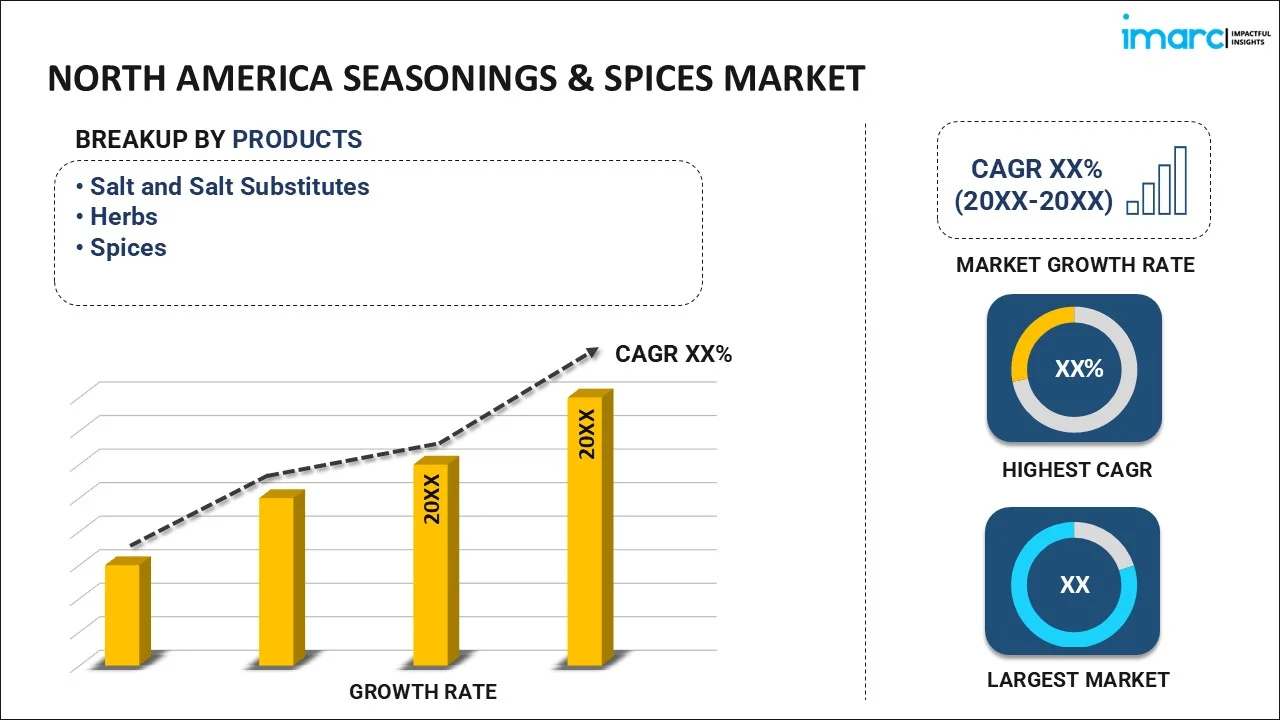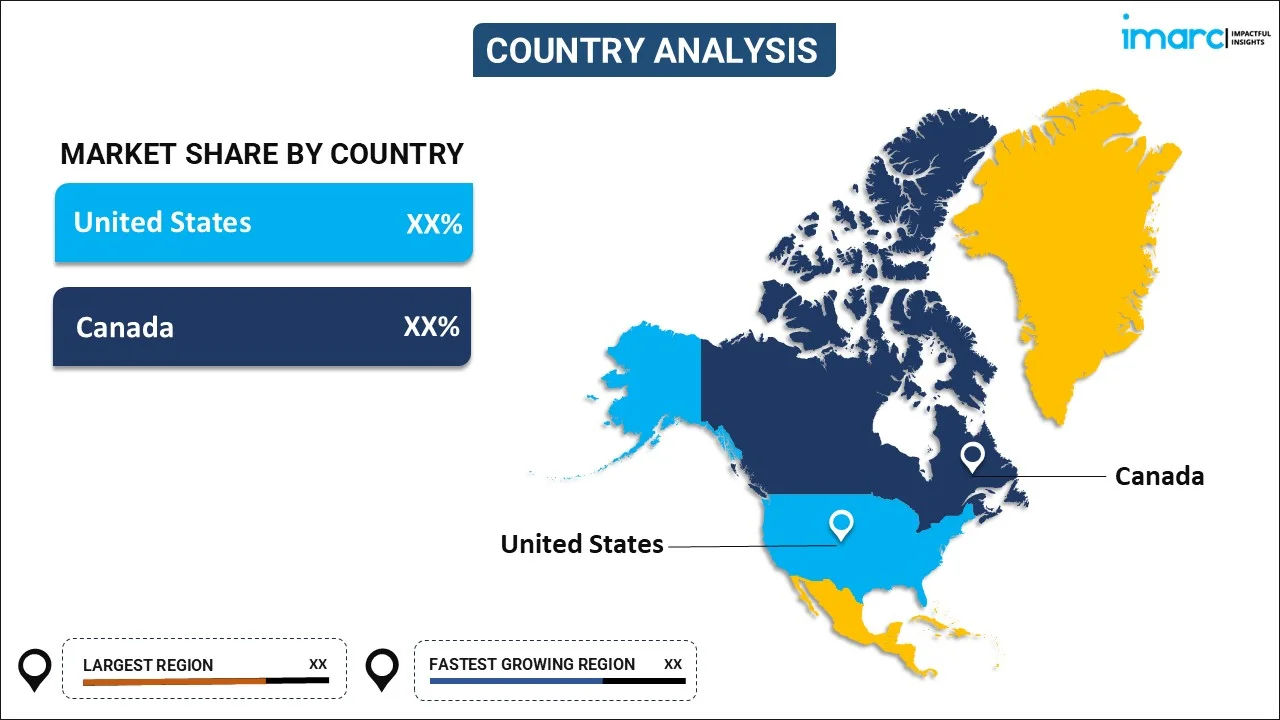
North America Seasonings & Spices Market Size, Share, Trends and Forecast by Product, Application, and Country, 2025-2033
North America Seasonings & Spices Market Overview:
The North America seasonings & spices market size reached USD 7.62 Billion in 2024. Looking forward, IMARC Group expects the market to reach USD 11.81 Billion by 2033, exhibiting a growth rate (CAGR) of 5.00% during 2025-2033. The North America seasonings and spices market is fueled by increased consumer demand for multi-diverse and intense flavors, healthy eating, as well as ethnic food trends. Further, the increasing popularity of home cooking, natural and organic product demand, and improved awareness about the health advantages of spices also drive market growth.
|
Report Attribute
|
Key Statistics
|
|---|---|
|
Base Year
|
2024
|
|
Forecast Years
|
2025-2033
|
|
Historical Years
|
2019-2024
|
| Market Size in 2024 | USD 7.62 Billion |
| Market Forecast in 2033 | USD 11.81 Billion |
| Market Growth Rate 2025-2033 | 5.00% |
North America Seasonings & Spices Market Trends:
Growing Popularity of Spicy and Bold Flavors
In North America, demand for hot, bold flavor in spices and seasonings is increasing at a fast pace. This can be attributed to evolving consumer tastes and greater use of global cuisine, with Latin American, Asian, and African food cultures being the major contributors. For instance, in 2024, the Kraft Heinz Company announced the debut of Just Spices in the U.S. market. For Kraft Heinz's Taste Elevation division, which focuses on flavor improvement and is one of the company's platforms for ongoing growth as delineated in its long-term plan, Just Spices is anticipated to be a crucial growth driver. Consumers are also looking for hot, pungent flavors to add to their foods, with some of the most popular spices being chili peppers, cayenne, Sriracha, and chipotle. This trend is reflective of a broader cultural fascination with intense, multifaceted flavors that taste and burn. Industry has responded by creating a wide range of products to meet the demands of spice lovers. For instance, spicy snack foods, condiments, and spice blends tailored for different burning strengths have become numerous. Ranging from mildly spicy to brutally hot, the foods allow customers to experiment with multiple levels of burning strength. Furthermore, fast-food chains, grocery stores, and restaurants have placed more spicy food items on menus to attract consumers seeking such pungent foods. Spices like chili peppers have been believed to have metabolism-enhancing effects and can even assist in causing weight loss, which sounds alluring to health-conscious consumers. The rise in popularity of hot sauces and spicy seasonings is also linked to the growing trend of cooking at home, where consumers enjoy personalizing their meals with bold, spicy flavors.
Increasing Preference for Natural and Clean Label Seasonings
Another significant trend in the North American seasonings and spices market is the increasing consumer preference for natural and clean label products. As people become more aware of the ingredients in their food, many are looking for seasonings and spices that are free from artificial additives, preservatives, and synthetic flavors. This shift is driving the growth of organic and non-GMO spice products, with consumers prioritizing authenticity and transparency in the foods they purchase. Manufacturers are responding by focusing on ingredient integrity and offering products that highlight all-natural, clean label ingredients. For instance, in July 2024, the first nationally distributed Regenerative Organic Certified bottled spices are being introduced by Frontier Co-op, a leading brand of culinary herbs, spices, and baking flavors, to help smallholder farmers and provide consumers with culinary options that have a positive impact on the environment, ethics, and society. Brands are also leaning into sustainability by sourcing spices responsibly and ensuring ethical farming practices, which resonates with environmentally conscious consumers. Moreover, the clean label trend is leading to an emphasis on spices that are free from fillers or non-essential additives. Seasonings made with minimal ingredients—such as sea salt, pepper, garlic, and herbs—are gaining traction, particularly among consumers seeking products that are simpler and closer to their natural form. This movement is also linked to the growing interest in plant-based and whole-food diets, where spices are used to enhance flavors without relying on heavily processed ingredients.
North America Seasonings & Spices Market Segmentation:
IMARC Group provides an analysis of the key trends in each segment of the market, along with forecasts at the country level for 2025-2033. Our report has categorized the market based on product, application, and country.
Product Insights:

- Salt and Salt Substitutes
- Herbs
- Thyme
- Basil
- Oregano
- Parsley
- Others
- Spices
- Pepper
- Cardamom
- Cinnamon
- Clove
- Nutmeg
- Others
The report has provided a detailed breakup and analysis of the market based on the chemical type. This includes salt and salt substitutes, herbs (thyme, basil, oregano, parsley and others), and spices (pepper, cardamom, cinnamon, clove, nutmeg and others).
Application Insights:
- Meat and Poultry Products
- Snacks and Convenience Food
- Soups, Sauces and Dressings
- Bakery and Confectionary
- Frozen Products
- Beverages
- Others
A detailed breakup and analysis of the market based on the application have also been provided in the report. This includes meat and poultry products, snacks and convenience food, soups, sauces and dressings, bakery and confectionary, frozen products, beverages, and others.
Country Insights:

- United States
- Canada
The report has also provided a comprehensive analysis of all the major regional markets, which include Unites States and Canada.
Competitive Landscape:
The market research report has also provided a comprehensive analysis of the competitive landscape. Competitive analysis such as market structure, key player positioning, top winning strategies, competitive dashboard, and company evaluation quadrant has been covered in the report. Also, detailed profiles of all major companies have been provided.
North America Seasonings & Spices Market News:
- In January 2024, Flavor Maker Seasonings, a new range from the McCormick brand, is designed to flavor and inspire meals from preparation to serving. These delicious and adaptable seasonings provide flavor quickly and easily as a topping or as an ingredient in cooking. They come in the following varieties, namely mac & cheese, mediterranean, taco, Asian-style rice bowl, chicken, veggie and pasta.
North America Seasonings & Spices Market Report Coverage:
| Report Features | Details |
|---|---|
| Base Year of the Analysis | 2024 |
| Historical Period | 2019-2024 |
| Forecast Period | 2025-2033 |
| Units | Billion USD |
| Scope of the Report |
Exploration of Historical Trends and Market Outlook, Industry Catalysts and Challenges, Segment-Wise Historical and Future Market Assessment:
|
| Products Covered |
|
| Applications Covered | Meat and Poultry Products, Snacks and Convenience Food, Soups, Sauces and Dressings, Bakery and Confectionary, Frozen Products, Beverages, and Others. |
| Countries Covered | United States, Canada |
| Customization Scope | 10% Free Customization |
| Post-Sale Analyst Support | 10-12 Weeks |
| Delivery Format | PDF and Excel through Email (We can also provide the editable version of the report in PPT/Word format on special request) |
Key Questions Answered in This Report:
- How has the North America seasonings & spices market performed so far and how will it perform in the coming years?
- What is the breakup of the North America seasonings & spices market on the basis of product?
- What is the breakup of the North America seasonings & spices market on the basis of application?
- What are the various stages in the value chain of the North America seasonings & spices market?
- What are the key driving factors and challenges in the North America seasonings & spices market?
- What is the structure of the North America seasonings & spices market and who are the key players?
- What is the degree of competition in the North America seasonings & spices market?
Key Benefits for Stakeholders:
- IMARC’s industry report offers a comprehensive quantitative analysis of various market segments, historical and current market trends, market forecasts, and dynamics of the North America seasonings & spices market from 2019-2033.
- The research report provides the latest information on the market drivers, challenges, and opportunities in the North America seasonings & spices market.
- Porter's five forces analysis assist stakeholders in assessing the impact of new entrants, competitive rivalry, supplier power, buyer power, and the threat of substitution. It helps stakeholders to analyze the level of competition within the North America seasonings & spices industry and its attractiveness.
- Competitive landscape allows stakeholders to understand their competitive environment and provides an insight into the current positions of key players in the market.
Need more help?
- Speak to our experienced analysts for insights on the current market scenarios.
- Include additional segments and countries to customize the report as per your requirement.
- Gain an unparalleled competitive advantage in your domain by understanding how to utilize the report and positively impacting your operations and revenue.
- For further assistance, please connect with our analysts.
 Inquire Before Buying
Inquire Before Buying
 Speak to an Analyst
Speak to an Analyst
 Request Brochure
Request Brochure
 Request Customization
Request Customization




.webp)




.webp)












